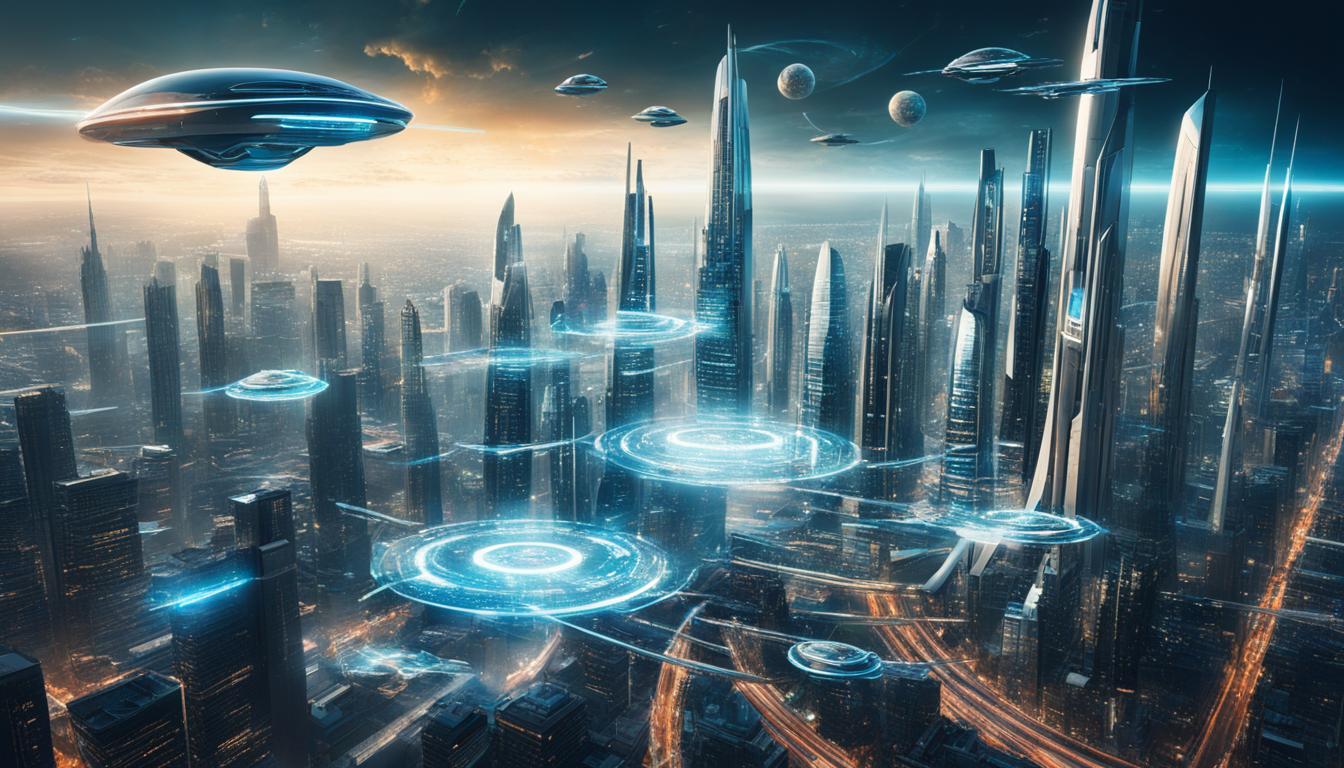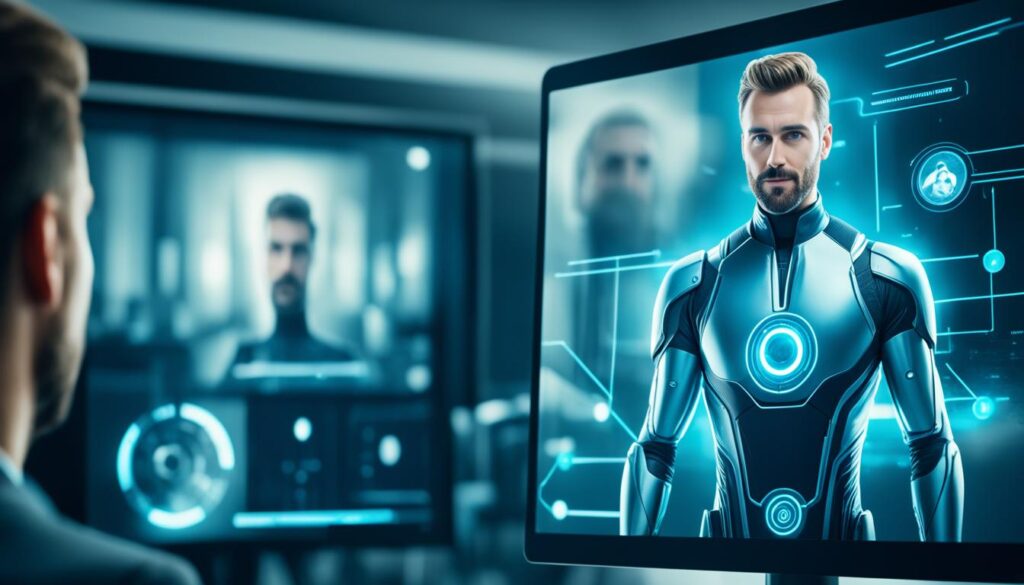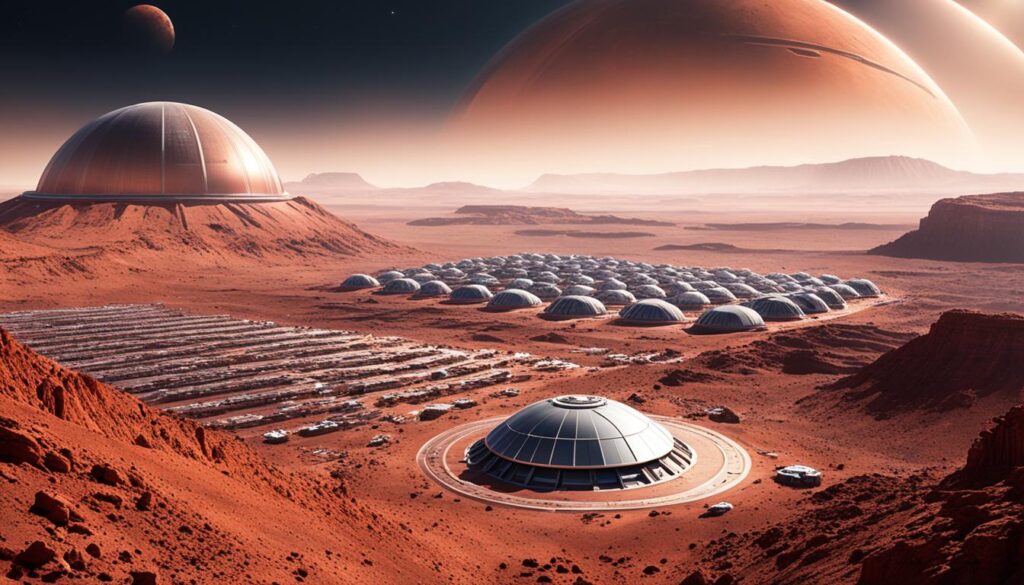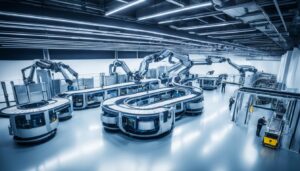
Science fiction writers have always possessed the ability to envision the future, often predicting technological advancements that seemed beyond the realm of possibility at the time. From futuristic gadgets to groundbreaking concepts, their foresight has proven to be remarkably accurate. In this article, we will explore the remarkable predictions made by science fiction writers and the impact they have had on shaping the world we live in today.
Science fiction authors possess the unique ability to imagine possibilities that go beyond the limits of current technology. Through their stories, they have provided glimpses into what the future may hold, allowing readers to expand their imaginations and push the boundaries of human innovation.
Key Takeaways:
- Science fiction writers have a long history of accurately predicting technological advancements.
- Tablets, video calling, Mars colonization, and artificial intelligence are just a few examples of technologies foreseen by science fiction writers.
- The influence of science fiction on technological innovation is undeniable, inspiring scientists and inventors to turn fictional ideas into reality.
- Science fiction continues to shape the future of technology, reminding us of the power of storytelling and human imagination.
- Exploring science fiction literature can offer insights into the potential technologies that may shape our future.
Tablets: Envisioned by Science Fiction Writers
Science fiction writers have a remarkable ability to envision future technologies well before they become a reality. One such example is the concept of tablet-like devices, which were predicted by renowned authors like Arthur C. Clarke and the creators of “Star Trek”.
In Arthur C. Clarke’s iconic novel “2001: A Space Odyssey”, published in 1968, he described a handheld device called the “Newspad” that allowed characters to access information, news, and books on a portable screen. This tablet-like device bears a striking resemblance to the modern-day tablets we use today.
“Star Trek: The Next Generation”, a popular science fiction television series that aired from 1987 to 1994, featured a device known as the “PADD” (Personal Access Display Device). The PADD was a hand-held computer used by the characters to read reports, access information, and communicate wirelessly. It too anticipated the functionality of modern tablets.
These early visions of tablet-like devices in science fiction laid the groundwork for the development of real-life tablets. Today, tablets are an integral part of our technological landscape, offering a portable and intuitive way to browse the internet, read e-books, watch videos, and much more.
“Any sufficiently advanced technology is indistinguishable from magic.” – Arthur C. Clarke
The influence of science fiction on real-world technology is undeniable. By portraying futuristic tablets in their works, science fiction authors sparked the imagination of inventors and set the stage for technological advancements. Their visionary ideas have become a tangible reality, transforming the way we access and interact with information.
Futuristic Tablet-like Devices Envisioned by Sci-Fi Authors
| Sci-Fi Author | Work | Year |
|---|---|---|
| Arthur C. Clarke | “2001: A Space Odyssey” | 1968 |
| Gene Roddenberry, Rick Berman, and Michael Piller | “Star Trek: The Next Generation” | 1987-1994 |
These visionary authors not only inspired the development of tablets but also pushed the boundaries of innovation in the technology sector. Their foresight serves as a reminder of the power of science fiction in shaping our future.
Video Calling: A Sci-Fi Prediction Come True
Science fiction novels and shows have long portrayed the idea of video calling. Authors and creators have envisioned a future where visual communication is possible, connecting people across vast distances. One of the earliest instances of video calling in science fiction is found in Jules Verne’s “The Begum’s Fortune,” where he introduced the concept of the “phonotelephote.” This fictional device allowed characters to communicate using both audio and visual cues, bringing them closer together despite physical separation.

Science fiction authors and filmmakers have continued to explore and depict video communication predictions. The 1964 World’s Fair even showcased the idea of video calling to the public, further fueling the collective imagination. As technology evolved and advanced, video calling became a reality. Platforms like Skype and FaceTime now enable individuals to connect face-to-face, bridging long distances and bringing people together virtually.
“Science fiction is filled with predictions that turned into reality. One very uncanny prediction was video calling. Back then, it was just an idea for futuristic novels and movies, but today, it is an essential part of how we communicate.”
Video calling has revolutionized the way we interact, allowing for visual communication that was once only possible in the realm of science fiction. It has transformed businesses, connecting colleagues and clients from different corners of the world. It has also brought families and friends closer, fostering a sense of togetherness even when physically apart.
The Advantages of Video Calling
Video calling offers numerous benefits beyond simple phone calls or instant messaging. Some advantages include:
- Face-to-Face Communication: Video calling allows you to see the person you’re talking to, making conversations more personal and engaging.
- Non-Verbal Cues: Visual communication enables the exchange of non-verbal cues like facial expressions and body language, enhancing understanding and emotional connection.
- Global Connectivity: With video calling, you can bridge the distance between continents and time zones, making it easier to communicate with colleagues, clients, and loved ones around the world.
- Collaboration and Productivity: Video calling facilitates collaboration, allowing teams to work together efficiently, regardless of their physical location.
As technology continues to advance, video calling will likely become even more prevalent and seamless. The achievements of science fiction have paved the way for this innovative form of communication, connecting people in ways once unimaginable.
| Advantages of Video Calling | Examples |
|---|---|
| Face-to-Face Communication | Seeing the expressions of loved ones during a virtual family gathering |
| Non-Verbal Cues | Observing a colleague’s body language during a video conference |
| Global Connectivity | Attending a job interview with a company located in another country |
| Collaboration and Productivity | Working on a project with teammates spread across different time zones |
Mars Colonization: From Science Fiction to Reality
Visionary science fiction authors like Kim Stanley Robinson and Robert A. Heinlein have long imagined human colonies on Mars. Their novels depicted massive domed cities and advanced technology on the Red Planet. Today, organizations like SpaceX are actively working on plans for Mars colonization, aiming to establish self-sustaining colonies in the future. While there are challenges to overcome, the dream of Mars colonization is becoming more attainable.
These sci-fi depictions of Mars settlements have sparked the imagination of scientists, engineers, and space enthusiasts, inspiring them to turn these fictional scenarios into potential realities. Mars colonization predictions in science fiction have served as blueprints for future missions and have shaped our understanding of what life on Mars could look like.
Sci-fi authors have envisioned Mars colonies with intricate details, describing everything from the architecture of the habitats to the social dynamics among the settlers. Their vivid portrayals of Mars colonies have fueled discussions and debates among scientists, policymakers, and the general public about the feasibility and implications of human habitation on the Red Planet.
The journey towards Mars colonization is not without its challenges. The harsh Martian environment, limited resources, and the long duration of space travel pose significant hurdles. However, advancements in technology, such as reusable rockets and sustainable life support systems, bring us closer to making these sci-fi visions a reality.

| Sci-Fi Mars Colonization Predictions | Real-world Mars Colonization Efforts |
|---|---|
| Domed cities providing a controlled environment for settlers | Development of reliable life support systems and sustainable habitats |
| Advanced technology for energy generation and resource utilization | Research and testing of technologies like solar panels and in-situ resource utilization |
| Complex social dynamics and governance systems among the settlers | Study of psychosocial factors and development of protocols for long-duration space missions |
The crossover between science fiction and real-world Mars colonization efforts continues to inspire scientists, engineers, and entrepreneurs to explore innovative solutions. The Mars colonies envisioned by sci-fi authors ignite our imagination, pushing us to overcome scientific, technical, and logistical challenges to establish a human presence beyond Earth.
Artificial Intelligence: From Fictional Robots to Real-World AI
Science fiction literature has long been a source of inspiration for artificial intelligence (AI) development. Visionary authors like Isaac Asimov explored the ethical implications of intelligent machines, laying the foundation for real-world advancements. Works such as Mary Shelley’s “Frankenstein” and Asimov’s “I, Robot” have shaped the discourse on AI, highlighting its potential and raising important questions.
In Shelley’s “Frankenstein,” the creation of an artificially intelligent being challenges the boundaries of science and morality. Asimov’s “I, Robot” delves into the complex relationship between humans and robots, exploring themes of ethics and responsibility. These early works sparked the imagination of scientists and set the stage for the development of AI technologies.
Today, researchers and scientists are making significant progress in AI development. Intelligent machines capable of learning, reasoning, and performing complex tasks are now a reality. From machine learning algorithms that power recommendation systems to sophisticated chatbots that provide customer support, AI has become an integral part of our daily lives.
The field of AI continues to evolve and expand, with advancements in areas such as natural language processing, computer vision, and autonomous systems. Companies like Google, Microsoft, and IBM are at the forefront of AI research, driving innovation and pushing the boundaries of what is possible.
“The development of full artificial intelligence could spell the end of the human race.”
– Stephen Hawking
While AI in science fiction often portrays a dystopian future where machines dominate humanity, it is important to recognize the positive impacts of AI in the real world. AI technologies have the potential to revolutionize industries, from healthcare and finance to transportation and entertainment. With responsible development and careful implementation, AI can enhance our lives and address some of the world’s most pressing challenges.
As society continues to navigate the complexities of AI, science fiction remains a valuable source of inspiration and caution. It allows us to explore the ethical dilemmas, societal implications, and potential risks associated with advancing AI technologies. By learning from science fiction and combining it with rigorous scientific research and ethical considerations, we can strive for a future where AI benefits humanity as a whole.

Advancements in AI: Real-World Applications
AI is already transforming various industries, revolutionizing the way we live and work. Here are a few examples of real-world applications of AI:
- Autonomous vehicles: AI-powered self-driving cars are being developed by companies like Tesla and Waymo, with the potential to reduce accidents and congestion while improving transportation efficiency.
- Personalized healthcare: AI algorithms can analyze medical data to provide tailored treatment plans and predictions, improving diagnostics and patient outcomes.
- Virtual assistants: Intelligent virtual assistants like Amazon’s Alexa and Apple’s Siri utilize natural language processing to understand and respond to user commands, making daily tasks more convenient.
- Financial forecasting: AI-powered algorithms can analyze vast amounts of financial data to make accurate predictions, assisting in investment decisions and risk management.
These advancements are just the beginning, as AI continues to push the boundaries of what is possible. By combining the imaginative visions of science fiction with the advancements of real-world AI, we can steer the development of intelligent machines towards a future that benefits humanity.
The Impact of Science Fiction on Technological Innovation
Science fiction has had a profound influence on technological innovation, shaping the world we live in today. The imaginative ideas and concepts presented in science fiction works have sparked the imaginations of scientists and inventors, leading to real-world advancements and breakthroughs. From space travel to virtual reality, science fiction has pushed the boundaries of what is possible, inspiring and driving innovation across various fields.
Science fiction serves as a creative platform for exploring the potential of future technologies, often presenting visionary ideas that provoke thought and curiosity. Authors like Jules Verne, Arthur C. Clarke, and Isaac Asimov have captivated readers with their depictions of futuristic worlds filled with advanced technology and scientific discoveries.
One of the most notable examples of science fiction’s impact on technology is the influence of the Star Trek franchise. The iconic series introduced concepts like handheld communication devices and tablet-like computers that have shaped the development of modern smartphones and tablets. The communicators used by the crew of the Starship Enterprise foreshadowed the invention of mobile phones, while the personal access display devices (PADDs) in the show set the stage for the creation of tablet computers.
“The dream of colonizing Mars gained traction through science fiction, inspiring the scientific community to explore the possibilities of making humans an interplanetary species.”
Science fiction has also played a significant role in popularizing the idea of space exploration and colonization. Authors such as Kim Stanley Robinson and Robert A. Heinlein have depicted Mars colonies with intricate details and technological advancements. These sci-fi depictions have spurred the interest of space agencies and private companies in exploring the Red Planet, with organizations like SpaceX actively working towards the goal of establishing human settlements on Mars.
Artificial intelligence (AI) is another area where science fiction has had a profound impact. Early works like Mary Shelley’s “Frankenstein” and Isaac Asimov’s “I, Robot” explored the ethical implications of intelligent machines, planting the seeds for real-world AI research. Today, AI technologies are rapidly advancing, with machine learning algorithms and autonomous systems transforming various industries, including healthcare, finance, and transportation.
Science Fiction’s Role in Technological Advancements
Science fiction serves as a catalyst for innovation by expanding our imagination and challenging the limitations of current technologies. It inspires scientists, engineers, and entrepreneurs to push the boundaries of what is possible, driving progress and leading to groundbreaking inventions.
By envisioning futuristic technologies, science fiction provides a glimpse into possible futures, helping society anticipate the changes and challenges that lie ahead. It encourages us to ask critical questions about the ethical, social, and philosophical implications of emerging technologies, fostering important discussions and shaping responsible innovation.
| Technological Advancement | Science Fiction Inspiration |
|---|---|
| Tablet Computers | Arthur C. Clarke’s “2001: A Space Odyssey” |
| Video Calling | Jules Verne’s “The Begum’s Fortune” |
| Mars Colonization | Kim Stanley Robinson’s “Red Mars” |
| Artificial Intelligence | Isaac Asimov’s “I, Robot” |
As technology continues to advance at an unprecedented pace, science fiction remains a source of inspiration and imagination. It challenges us to think creatively about the future and pushes us to turn fiction into reality. The influence of science fiction on technology is undeniable, and its impact on innovation will continue to shape the world for generations to come.

Are there any instances where science fiction writers predicted sports technology advancements?
Science fiction writers have often predicted advancements in sports technology, legitimizing the concept of sports technology labs legitimacy. From exoskeletons enhancing athletic performance to virtual reality training simulations, these authors have been ahead of their time. Their imaginative portrayal of future sports technology has often foreshadowed real-life innovations.
Conclusion
Science fiction writers possess an incredible ability to predict future technologies, offering insights into the possibilities of tomorrow. From the early concept of tablet computers envisioned by Arthur C. Clarke and “Star Trek,” to the realization of video calling inspired by Jules Verne, these visionary authors have shaped our technological landscape. Their imaginative foresight serves as a testament to the power of storytelling and the boundless potential of human innovation.
Mars colonization, once confined to the pages of science fiction novels, is becoming a tangible reality with ongoing efforts by organizations like SpaceX. As we strive towards self-sustaining colonies on the Red Planet, we are reminded that the dreams and ideas of science fiction can spark real-world change.
Artificial intelligence, which has captivated our imaginations for years, is no longer confined to the realm of fiction. With pioneers like Isaac Asimov paving the way, advancements in AI technology have skyrocketed. Intelligent machines capable of learning, reasoning, and performing complex tasks are now present in our daily lives, shaping a future that was once only a figment of our imagination.
The impact of science fiction on technological innovation cannot be overstated. Its influence has inspired scientists and inventors to push the boundaries of possibilities, resulting in groundbreaking advancements. From space travel to virtual reality, it is clear that the visionary ideas of science fiction authors continue to shape our world and hold the key to unlocking the extraordinary potential of our future.








